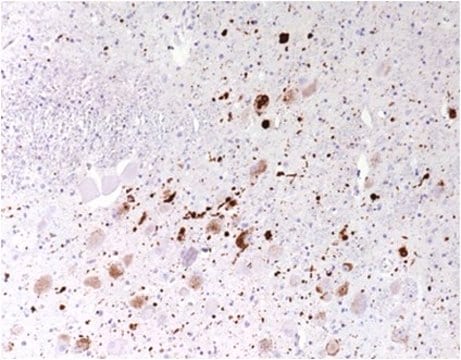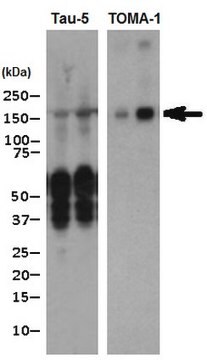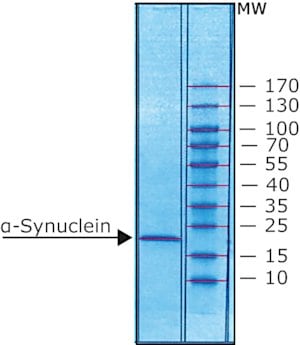ABN2265
Anti-alpha-Synuclein Antibody, oligomer-specific Syn33
from rabbit
Synonym(s):
oligomeric alpha-synuclein, Non-A beta component of AD amyloid, Non-A4 component of amyloid precursor, NACP
About This Item
Recommended Products
biological source
rabbit
Quality Level
antibody form
purified antibody
antibody product type
primary antibodies
clone
polyclonal
species reactivity
human
packaging
antibody small pack of 25 μg
technique(s)
ELISA: suitable
immunofluorescence: suitable
inhibition assay: suitable
western blot: suitable
isotype
IgG
UniProt accession no.
target post-translational modification
unmodified
Gene Information
human ... SNCA(6622)
General description
Specificity
Immunogen
Application
Western Blotting Analysis: A representative lot detected recombinant alpha-Synuclein, oligomers. (Sengupta, U., et. al. (2015). Biol Psychiatry. 78(10):672-83).
Western Blotting Analysis: A representative lot detected recombinant alpha-Synuclein, oligomer. (Courtesy of Dr. Rakez Kayed′s laboratory at University of Texas Medical Branch, Galveston).
ELISA Analysis: A representative lot detected alpha-Synuclein, oligomers in ELISA application (Sengupta, U., et. al. (2015). Biol Psychiatry. 78(10):672-83).
Inhibition Analysis: A representative lot inhibited cytotoxicity exerted alpha-synuclein oligomers in human neuroblastoma SH-SY5Y cells measured by MTT-based assay (Sengupta, U., et. al. (2015). Biol Psychiatry. 78(10):672-83).
Apoptosis & Cancer
Quality
Western Blotting Analysis: A 1:500 dilution of this antibody detected alpha-Synuclein in alpha Synuclein aggregates.
Physical form
Storage and Stability
Other Notes
Disclaimer
Not finding the right product?
Try our Product Selector Tool.
recommended
Storage Class Code
12 - Non Combustible Liquids
WGK
WGK 1
Flash Point(F)
Not applicable
Flash Point(C)
Not applicable
Certificates of Analysis (COA)
Search for Certificates of Analysis (COA) by entering the products Lot/Batch Number. Lot and Batch Numbers can be found on a product’s label following the words ‘Lot’ or ‘Batch’.
Already Own This Product?
Find documentation for the products that you have recently purchased in the Document Library.
Our team of scientists has experience in all areas of research including Life Science, Material Science, Chemical Synthesis, Chromatography, Analytical and many others.
Contact Technical Service








